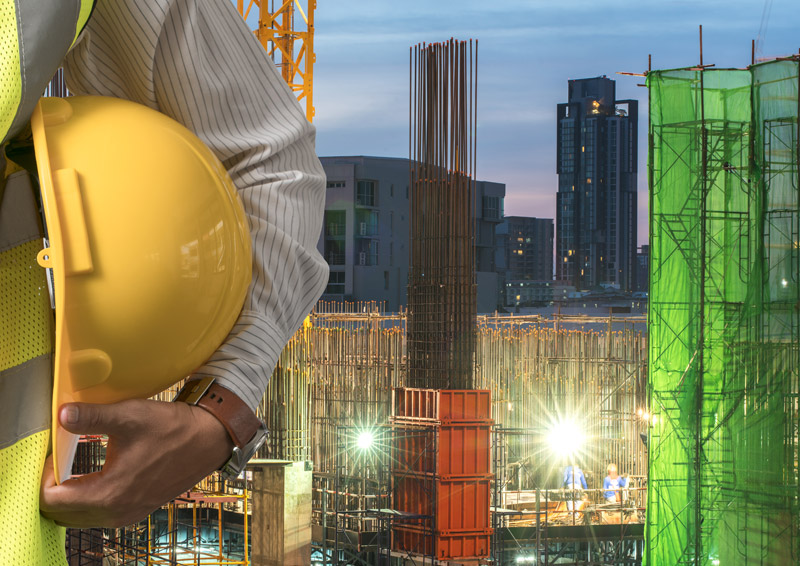In light of the COVID-19 health and safety guidance available so far, Dr Ciaran McAleenan looks ahead at the role engineers can play in improving workers’ safety.

- Updated: 18 May 2020
- Author: Author: Dr Ciaran McAleenan CEng MICE, Chair of Institution of Civil Engineers Expert H&S Panel
When ICE Publishing published the Second edition of ICE Manual of Health and Safety in Construction, we included a substantial section dedicated to health issues for construction professionals to consider, including dealing with biological hazards. I don’t believe anyone imagined back then that by 2020 we would be in the throes of a global pandemic with more than 3 million people infected, lockdowns and severe travel restrictions imposed. Many businesses around the world are at a virtual standstill. Understandably many are focused on their families right now, given the nature of this pandemic and the wide range of conflicting opinions offered and directions taken by the world’s leaders. This public health emergency is also an economic crisis affecting the whole of society. Some sections of society (the less affluent) are affected more than others and it isn’t crass to suggest addressing both crises in parallel. What would be callous is prioritising economic recovery.
However, that said, this is truly a challenge within a civil engineer’s skillset. So, what do we do? What must we do? To answer these questions I will consider immediate first response measures and then post-crisis recovery and resilience.
First, we should praise the emerging public goodwill towards essential and critical workers. Recognising that low-paid doesn’t mean low-skilled and, in fact, workers in health, pharmaceuticals, postal delivery, food retail, refuse collection and other council workers, to name a few, are hailed as critical to maintaining order on the frontlines, while managers self-isolate and home work. Maybe when the crisis abates and a ‘new normal’ transpires, society and the government will remember this and reward appropriately - not with medals or lapel badges, but rather with proper ongoing recognition of worth through correct rates of pay and access to all necessary safety, health and wellbeing resources, keeping workers free from harm. Now that would be a legacy to be proud of.
Back to what to do. In ICE Manual of Health and Safety in Construction, we discuss biosafety levels: 4 set by the US Centre for Disease Control and similarly 4 levels of exposure to biological agents addressed in EU Directive 90/679/EEC (EEC 1990). In this pandemic we are at the highest level, whichever system you study. It is worth noting that the EU directive focuses on protection of workers from the risk of exposure and that its annexes suggest several first response containment measures, including restricted access, protective clothing, signage, washing and decontamination facilities, controlled areas and controlled discharge of effluent. Details can be found in the directive (EEC 1990). The World Health Organization’s interim guidance identifies 4 scenarios, with advice on critical preparedness, readiness and response. The 4th scenario, ‘community transmission’, is our present situation and WHO recommends risk communication strategies, public health measures and infection prevention and control.
There is plenty of high quality scientific and medical advice out there so why the confusion? Maybe there is too much, maybe we only selectively hear and read what reinforces our strongly held beliefs, maybe we trust our politicians…but let me say that science will deliver the answers to this and politics should ONLY be the enabler. Political and economically driven answers to the current position will prolong the pandemic, potentially heightening the number of infections and fatalities.
The lockdown has been a useful (if stressful) first response strategy, focusing on medical care and maintenance of essential services, but that is when science, medicine, politics and economics should also be reflecting on next steps. How do we get out of this in a resilient and sustainable manner?
World health experts must lead; however, as mentioned, civil engineers are well placed in this challenge. We are design thinkers, trained and experienced in problem solving, not just in presenting solutions but also skilled in the ability to empathise with the inherent needs of workers, clients and society; after all, our works ‘contribute to the wellbeing of mankind’ and there has never been a better time to deliver. But let’s not just seek the obvious, ‘tried and tested’ solution. We are way beyond that. We are now in an era demanding that we forensically dissect the problem, get to the root and build safe and healthy solutions from the base upwards. In Ireland, Construction Industry Federation published a wide range of guidance for those preparing to re-open construction sites (government restrictions permitting), and this includes guidance for designers continuing to work remotely. Construction Leadership Council in the UK has also produced guidelines.
Finally, good engineers will know that great design and construction is backed up by best advice and guidance. During this pandemic refer to credible sources for that advice; World Health Organization continually updates on the spread of and appropriate controls for coronavirus while ICE, as a learned society, provides excellent resources.
Discover the print version of ICE Manual of Health and Safety in Construction and visit ICE Virtual Library to find it in an eBook format.
